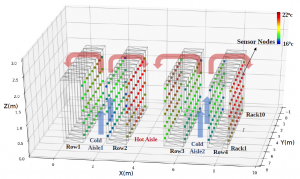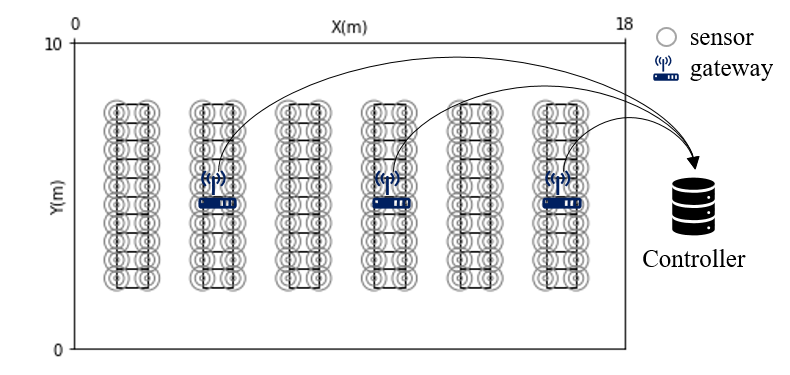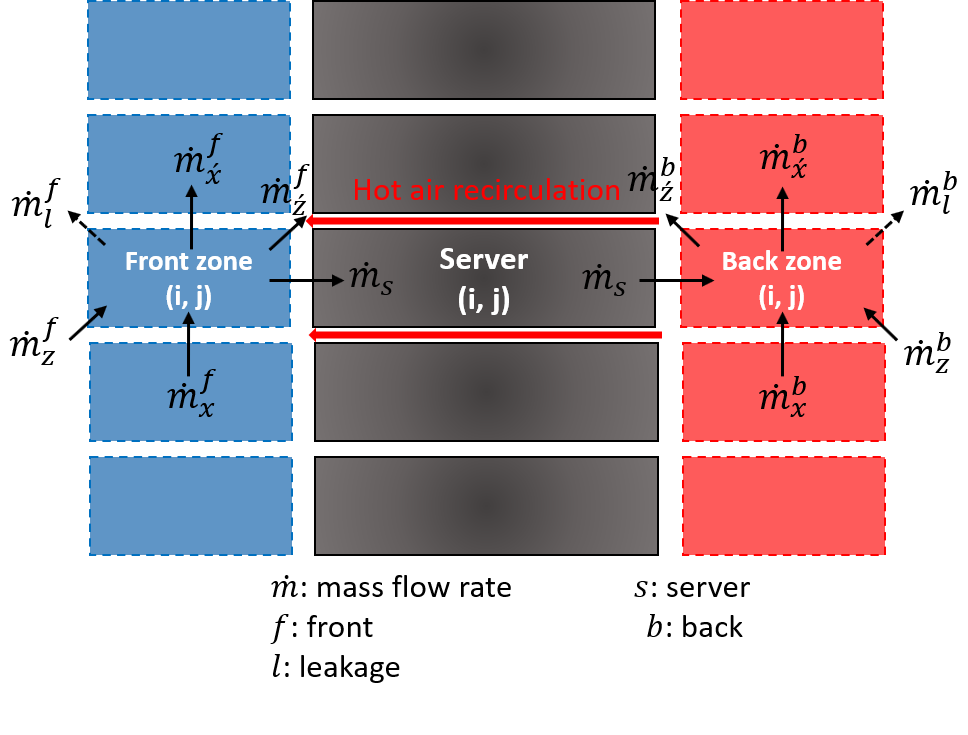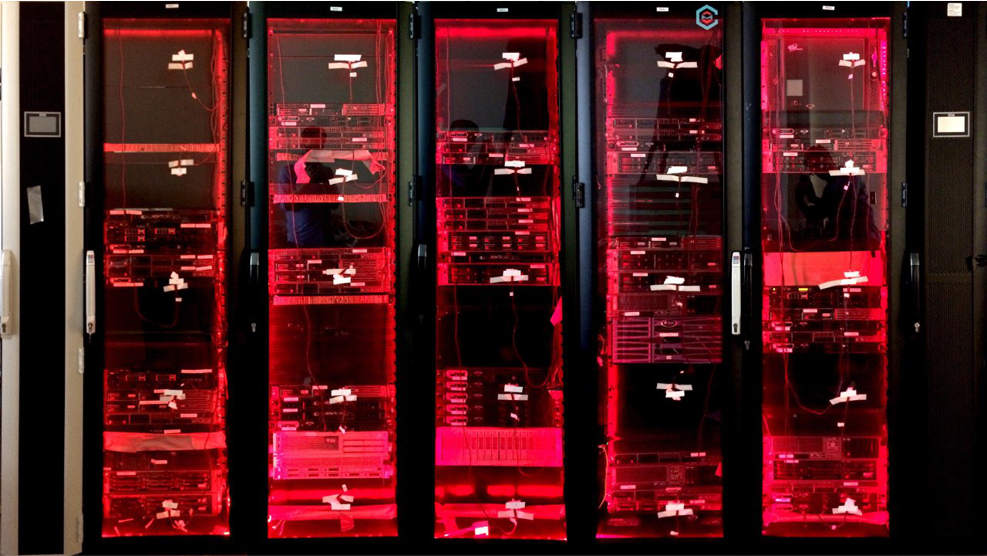Objectives #
According to the latest reports of the US Environmental Protection Agency (EPA), 70 billion kWh equals 1.8% of the whole electricity power of the U.S.was consumed in DCs by 2014. Up to 50% of this power is consumed for cooling of IT and communication equipment in a wasteful way. Inefficient regions in a DC are detectable based on high temporal and spatial fidelity maps of temperature, relative humidity, airflow, and other environmental parameters. These maps can also be used in predictive maintenance, floor planning, and smart ventilation of cooling units. The objective of this project was to facilitate environmental monitoring and predictive maintenance in data centers by studying the feasibility and performance of three different approaches or a combination of them:
- Physical modeling using Computational Fluid Dynamic (CFD) simulations and surrogate modeling
- Statistical modeling by machine learning.
- Real-time measurement by an automated data collection framework from wireless sensors.
|
 |
 |
Participant #
- Sahar Asgari (PhD)
- Mehdi Jafarizadeh (PhD)
- Chenhe Li (MSc)
- Jun (Tyler) Li (MSc)
- Xingzhi Liu (MSc)
- Ghada Badawy
Research Thrusts #
|
1- Data Center Wireless Sensor Networks
The main outcome of this research is a reliable, low-power, adaptable, and easy-to-commission Bluetooth Low Energy (BLE) based network architecture for Data Center Wireless Sensor Networks (DCWSNs). Toward this goal:
- A hierarchical network, named Low Energy Monitoring Network (LEMoNet) is designed and evaluated experimentally in a small-scale DC, by simulation in a medium scale DC, and through an analytical model in a large scale DC.
- LeMoNet is further improved by a Software-Defined Networking (SDN) based framework, named SoftBLE.
- Sensor deployment was accelerated by two automated sensor mapping approaches, named thermal piloting and multimodal sensor localization
|
 |
| 2- Hybrid Modeling for DCs
In this research, a fast, adaptive, and accurate hybrid surrogate model is developed by combining a DDM and physics-based relations to predict real-time temperatures in a DC. Toward this goal:
- An artificial neural network (ANN) in conjunction with a 3D zonal model is employed to predict the spatio-temporal temperature distributions.
- The model is compared with a black-box model based on a nonlinear autoregressive exogenous model (NARX) for interpolative and extrapolative predictions.
- The influence of varying server workload distribution and cooling unit operational conditions on temperature distribution is investigated.
|
 |
| 3- Fault Diagnosis in DCs
In this research, fault detection and diagnosis (FDD) algorithms and associated control strategies are applied to detect, diagnose, and isolate faults to ensure that the cooling system runs appropriately. Toward this goal:
- A rapid and accurate single and multiple FDD strategy are developed for a DC using data-driven fault classifiers informed by a gray-box temperature prediction model.
- OCSVM and Nonlinear AutoRegressive Exogenous (NARX) techniques are considered for fault detection.
- Two different data-driven classifiers, 2D-CNN and CNN_LSTM, are implemented to predict multiple simultaneous failures while using a few simultaneous failure conditions in training data.
|
 |
Publications #
1.
Asgari, Sahar; Moazamigoodarzi, Hosein; Tsai, Peiying Jennifer; Pal, Souvik; Zheng, Rong; Badawy, Ghada; Puri, Ishwar K
Hybrid Surrogate Model for Online Temperature and Pressure Predictions in Data Centers Journal Article
In: Future Generation Computer Systems, vol. 114, pp. 531–547, 2021.
@article{asgari2021hybrid,
title = {Hybrid Surrogate Model for Online Temperature and Pressure Predictions in Data Centers},
author = {Sahar Asgari and Hosein Moazamigoodarzi and Peiying Jennifer Tsai and Souvik Pal and Rong Zheng and Ghada Badawy and Ishwar K Puri},
year = {2021},
date = {2021-01-01},
journal = {Future Generation Computer Systems},
volume = {114},
pages = {531--547},
publisher = {North-Holland},
keywords = {},
pubstate = {published},
tppubtype = {article}
}
2.
Asgari, Sahar; MirhoseiniNejad, SeyedMorteza; Moazamigoodarzi, Hosein; Gupta, Rohit; Zheng, Rong; Puri, Ishwar K
A Gray-box Model for Real-time Transient Temperature Predictions in Data Centers Journal Article
In: Applied Thermal Engineering, pp. 116319, 2020.
@article{asgari2020gray,
title = {A Gray-box Model for Real-time Transient Temperature Predictions in Data Centers},
author = {Sahar Asgari and SeyedMorteza MirhoseiniNejad and Hosein Moazamigoodarzi and Rohit Gupta and Rong Zheng and Ishwar K Puri},
year = {2020},
date = {2020-01-01},
journal = {Applied Thermal Engineering},
pages = {116319},
publisher = {Pergamon},
keywords = {},
pubstate = {published},
tppubtype = {article}
}
3.
Jafarizadeh, Mehdi; Zheng, Rong
An Analytical Study of Low Energy Monitoring Networks for Large-Scale Data Centers Proceedings Article
In: GLOBECOM 2020-2020 IEEE Global Communications Conference, pp. 1–6, IEEE 2020.
@inproceedings{jafarizadeh2020analytical,
title = {An Analytical Study of Low Energy Monitoring Networks for Large-Scale Data Centers},
author = {Mehdi Jafarizadeh and Rong Zheng},
year = {2020},
date = {2020-01-01},
booktitle = {GLOBECOM 2020-2020 IEEE Global Communications Conference},
pages = {1--6},
organization = {IEEE},
keywords = {},
pubstate = {published},
tppubtype = {inproceedings}
}
4.
Li, Chenhe; Li, Jun; Jafarizadeh, Mehdi; Badaway, Ghada; Zheng, Rong
LEMoNet: Low Energy Wireless Sensor Network Design for Data Center Monitoring Proceedings Article
In: IFIP Networking, 2019.
@inproceedings{li2019lemonet,
title = {LEMoNet: Low Energy Wireless Sensor Network Design for Data Center Monitoring},
author = {Chenhe Li and Jun Li and Mehdi Jafarizadeh and Ghada Badaway and Rong Zheng},
year = {2019},
date = {2019-01-01},
booktitle = {IFIP Networking},
keywords = {},
pubstate = {published},
tppubtype = {inproceedings}
}
5.
Ni, Minming; Jafarizadeh, Mehdi; Zheng, Rong
On the Effect of Multi-Packet Reception on Redundant Gateways in LoRAWANs Proceedings Article
In: IEEE International Conference on Communications (ICC), 2019.
@inproceedings{ni2019effect,
title = {On the Effect of Multi-Packet Reception on Redundant Gateways in LoRAWANs},
author = {Minming Ni and Mehdi Jafarizadeh and Rong Zheng},
year = {2019},
date = {2019-01-01},
booktitle = {IEEE International Conference on Communications (ICC)},
keywords = {},
pubstate = {published},
tppubtype = {inproceedings}
}
6.
Jafarizadeh, Mehdi; Tsai, Peiying; Zheng, Rong
Thermal Piloting: A Novel Approach for Sensor Localization in Data Center Monitoring Proceedings Article
In: International Conference on Distributed Computing in Sensor Systems (DCOSS), 2019.
@inproceedings{jafarizadeh2019thermal,
title = {Thermal Piloting: A Novel Approach for Sensor Localization in Data Center Monitoring},
author = {Mehdi Jafarizadeh and Peiying Tsai and Rong Zheng},
year = {2019},
date = {2019-01-01},
booktitle = {International Conference on Distributed Computing in Sensor Systems (DCOSS)},
keywords = {},
pubstate = {published},
tppubtype = {inproceedings}
}
7.
Li, Chenhe; Li, Jun; Jafarizadeh, Mehdi; Badawy, Ghada; Zheng, Rong
To Monitor or Not: Lessons from Deploying Wireless Sensor Networks in Data Centers Proceedings Article
In: Proceedings of the 7th International Workshop on Real-World Embedded Wireless Systems and Networks (RealWSN'18), 2018.
@inproceedings{li2018monitor,
title = {To Monitor or Not: Lessons from Deploying Wireless Sensor Networks in Data Centers},
author = {Chenhe Li and Jun Li and Mehdi Jafarizadeh and Ghada Badawy and Rong Zheng},
year = {2018},
date = {2018-01-01},
booktitle = {Proceedings of the 7th International Workshop on Real-World Embedded Wireless Systems and Networks (RealWSN'18)},
keywords = {},
pubstate = {published},
tppubtype = {inproceedings}
}
Downloads #
Acknowledgement #
This research was in part supported by the collaborative research and development grant NSERC CRDPJ 500720 and NSERC Discovery grant.









